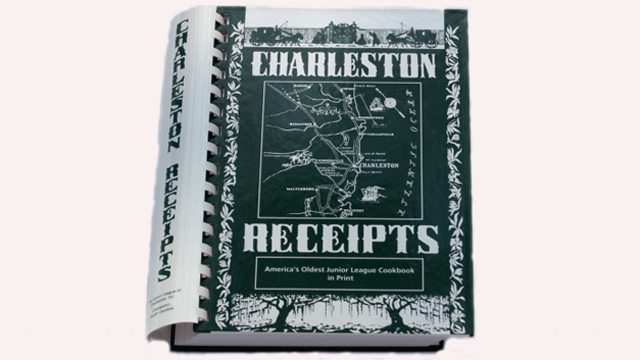
(Junior League of Charleston, South Carolina, Inc.)
“Eat local” in Charleston, South Carolina is more than a mantra; it’s a way of life.
“Arise early and go on the Lake and catch about eighteen Big-Mouth Bass, Bream or Red Breast,” reads the recipe for Otranto Pine Bark Stew. Then, “make an outdoor fire of pine bark.”
Find “yellow belly” cooters (turtles, preferably female) for Cooter Soup then, “kill cooter by chopping off head.” Invert till drained then “plunge into boiling water for five minutes.”
Braise oysters with butter, cream and sherry for Mrs. C. C. Calhoun’s Chafing Dish Oysters. Dust with cayenne, mace and salt and ladle over crisp waffles.
If you think the last recipe is very much more “Junior League” than the first two, you’d be right—anywhere other than Charleston. All three recipes are from Charleston Receipts, the nation’s oldest Junior League cookbook, published in 1950 and now in its 35th printing. “Receipt” is old Charlestonian for “recipes.”
- Meeting Street Crab Meat
- "Likker Pudding"
- Mrs. C.C. Calhoun's Chafing Dish Oysters
- Brandy Pudding
- Peppermint Stick Ice Cream
- Charlotte Russe
- Sausage Stuffing for Turkey
- Straws
- Red Rice
- Hopping John
- Cocktail Sauce for Shrimp, Crab, or Raw Vegetables
Great regional cookbooks showcase an area’s culinary treasures and bring local history to life through cooking. Charleston Receipts is a great regional cookbook.
“’Local’ is all we had,” laughs Vereen Coen, daughter of Charleston Receipts co-founding editor, Mary Vereen Huguenin. Huguenin’s generation was the last to eat what they grew, shot or caught. “The only reason Mrs. Waring’s Channel Bass receipt is in there,” explains Coen, “is because Mrs. Waring loved to fish.”
Proceeds from the nearly one million copies sold have benefited more than 40 Charleston organizations. Not bad for a group of ladies who only wanted to raise money to fund a speech and hearing center.
Huguenin, Anne Montague Stoney and their Junior League committee took one month to gather the book’s 750 receipts and two months to test them. “‘Vereen,’ my Papa said, ‘we’re going to be guineas pigs,’” laughs Coen.
After four months of compiling and organizing, they decided on a printing of 2000. “Mama said to Papa, ‘Tom, Harry says there’s just no way we can ever sell 2000 cookbooks,’” recalls Coen. ‘But I think he’s wrong.’” They sold out in four days.
The receipts reflect the area’s agricultural abundance and the influence of Lowcountry Gullah culture and cuisine. The Lowcountry is a geographic and cultural region along South Carolina’s coast and the Gullah people are descendents of slaves. Because of the area’s relative isolation they were able to preserve their culture, cooking and language.
In today’s environment the book’s Gulla phrases appear to echo language that conveys negative connotations of African-Americans. Not in this case. Gullah is an English-based Creole language with its own grammar, idiomatic expressions and vocabulary and is a vital and authentic part of the region. The Gullah phrases belong in that context.
Ingredients calling for a “peck” (as in Peter Piper) and a reference to Hollywood as “the movie colony” complete the time-warp feel, but the receipts themselves are all over the map.
Chicken and Almond Spread feels 50s-ish, while an anchovy, garlic, green onion, mayo and tarragon salad dressing feels current. Roast ‘possum—clean opossum as soon as possible after shooting,” then hang for forty-eight hours before skinning—and Rabbit Pie—decapitate and dress immediately after shooting—feel very Daniel Boone.
Charleston Light Dragoon Punch evokes Scarlett O’Hara with grenadine, rye, rum, green tea and twelve dozen oranges and lemons. Coffee Punch, one gallon of coffee poured over two quarts vanilla ice cream and one quart of whipped cream evokes… Starbucks.
Coeur a la Crème (traditionally served in heart-shaped molds) is an Atkins’ cream cheese and heavy cream fantasy that might give you a crise cardiaque, but you’ll go out smiling. Ditto for Roquefort Dressing with cream cheese, mayo, whipped cream, French dressing and Roquefort.
The receipts are written in the vernacular of the home cook—a short list of ingredients followed by a brief instructional paragraph. Most are simple, says Coen, and within people’s reach. The real treasure is the Menu section where editors painstakingly created four-, five- and six-course menus.
Coen, at nearly seventy-nine, is one of the last links to the book’s founders, is the book’s biggest cheerleader. “I’m not one of those who did the work,” she says, “but I’m one of the ones who take pride in what they did.”
Coen’s mother’s committee had the unwitting good fortune to write a cookbook that captured a way of life just as food and cooking were entering the industrial age. Since food is now trending anti-industrial Charleston Receipts feels new again, again.
